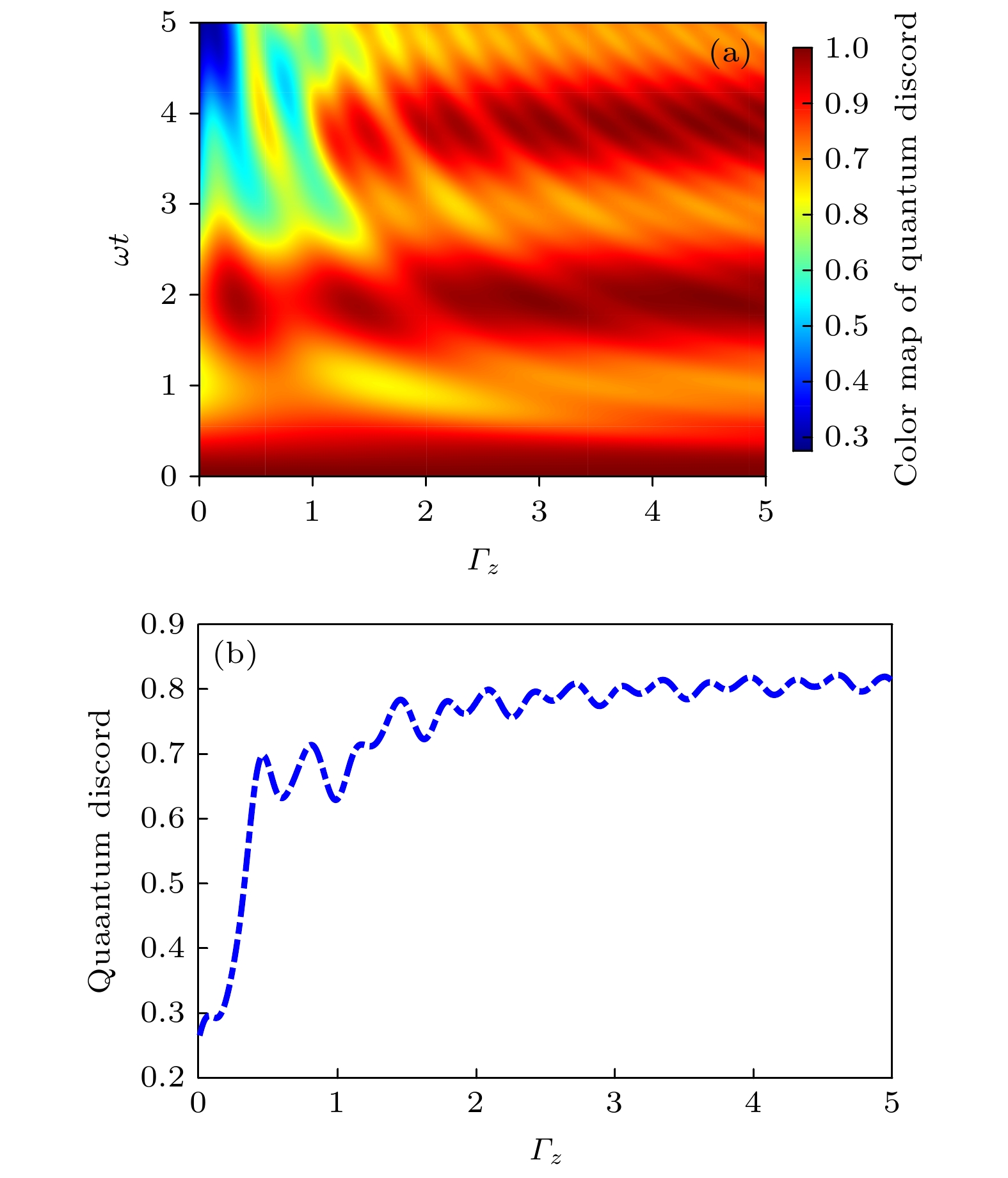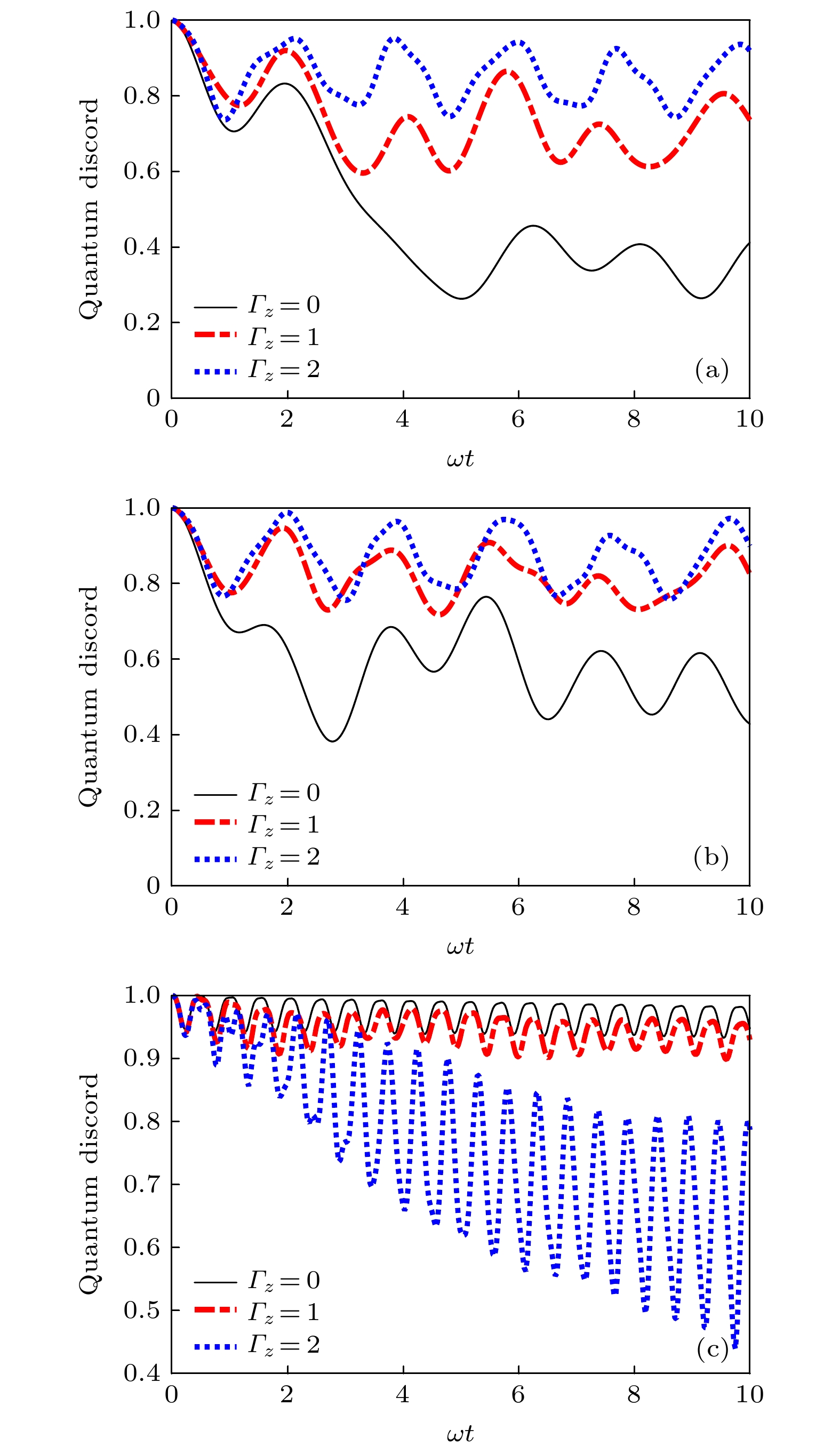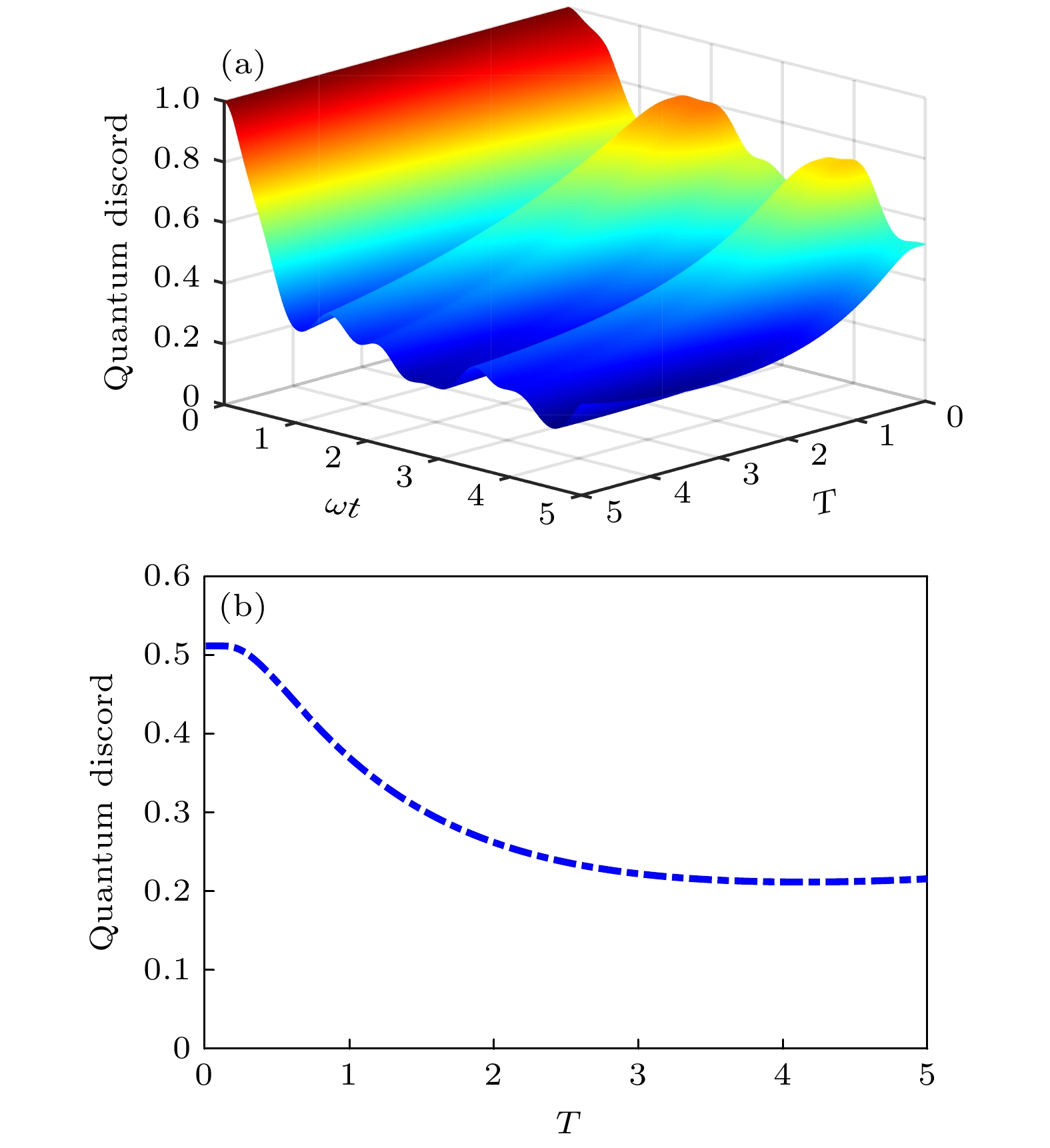-
自从Moriya和Kaplan在自旋轨道耦合的单带哈伯德模型中发现了对称的螺旋交换作用, Shekhtman, Entin和Aharony等用这种不可忽略的对称螺旋交换作用成功地解释了
$ {\text{L}}{{\text{a}}_{\text{2}}}{\text{Cu}}{{\text{O}}_{\text{4}}} $ 的弱铁磁性. 本文应用非马尔科夫量子态扩散方法研究了具有Kaplan-Shekhtman-Entin-Wohlman-Aharony相互作用和Dzyaloshinskii-Moriya相互作用的自旋链系统中量子失协的非马尔科夫动力学演化问题, 分析了Kaplan-Shekhtman-Entin-Wohlman-Aharony相互作用在零温和有限温度下不同外加磁场时对量子失协的影响. 结果表明, 在没有磁场或仅有均匀磁场的情况下, 系统中的量子失协可以通过增加Kaplan-Shekhtman-Entin-Wohlman-Aharony相互作用而增加, 而在非均匀磁场中则相反. 更重要的是, 通过调节均匀磁场和Kaplan-Shekhtman-Entin-Wohlman-Aharony相互作用可以得到理想的失协状态. 此外, 还分别讨论了Kaplan-Shekhtman-Entin-Wohlman-Aharony相互作用在马尔科夫环境和有限温度下对量子失协的影响.Since the discovery of symmetric helical interactions in the spin-orbit coupled single-band Hubbard model by Moriya and Kaplan, Shekhtman, Entin, Aharony et al. have successfully used this non-negligible symmetric helical exchange interaction to explain the weak ferromagnetism of La2CuO4. By using the non-Markovian quantum state diffusion method, the quantum discord of non-Markovian dynamics in the spin chain system that has Kaplan–Shekhtman–Entin-Wohlman–Aharony interactions and Dzyaloshinskii-Moriya interactions is studied. The effects of Kaplan–Shekhtman–Entin-Wohlman–Aharony interaction on the quantum discord under different external magnetic fields at zero and finite temperatures are discussed. The results show that the quantum discord in the system can be increased via the increasing of Kaplan–Shekhtman–Entin-Wohlman–Aharony interaction in the case of zero or uniform magnetic field, while the case is opposite under the nonuniform magnetic field. More importantly, the ideal discord state can be obtained by modulating the uniform magnetic field and Kaplan–Shekhtman–Entin-Wohlman–Aharony interaction. Moreover, the Markovian case and the effect of temperature on the quantum discord are also discussed, respectively.-
Keywords:
- non-markovian quantum state diffusion method /
- quantum discord /
- magnetic field /
- Kaplan-Shekhtman-entin-Wohlman-Aharony interaction
[1] Huang Y 2014 Phys. Rev. B 89 54410
 Google Scholar
Google Scholar
[2] Dakić B, Lipp Y O, Ma X, Ringbauer M, Kropatschek S, Barz S, Paterek T, Vedral V, Zeilinger A, Brukner Č, Walther P 2012 Nat. Phys. 8 666
 Google Scholar
Google Scholar
[3] Shahandeh F, Lund A P, Ralph T C 2019 Phys. Rev. A 99 052303
 Google Scholar
Google Scholar
[4] Ringbauer M, Costa F, Goggin M E, Andrew G W, Fedrizzi A 2018 NPJ Quantum Inf. 4 1
 Google Scholar
Google Scholar
[5] Ecker S, Bouchard F, Bulla L, Brandt F, Kohout O, Steinlechner F, Fickler R, Malik M, Guryanova Y, Ursin R, Huber M 2019 Phys. Rev. X 9 041042
 Google Scholar
Google Scholar
[6] Braun D, Adesso G, Benatti F, Floreanini R, Marzolino U, Mitchell M W, Pirandola S 2018 Rev. Mod. Phys. 90 035006
 Google Scholar
Google Scholar
[7] Wootters W K 1998 Phys. Rev. Lett. 80 2245
 Google Scholar
Google Scholar
[8] Mamtimin T, Ahmad A, Rabigul M 2013 Chin. Phys. Lett. 30 030303
 Google Scholar
Google Scholar
[9] Harold O, Zurek W H 2002 Phys. Rev. Lett. 88 017901
 Google Scholar
Google Scholar
[10] Ali M, Rau A, Alber G. 2010 Phys. Rev. A 81 82
 Google Scholar
Google Scholar
[11] Fanchini F F, Werlang T, Brasil C A 2010 Phys. Rev. A 81 52107
 Google Scholar
Google Scholar
[12] Daki B, Lipp Y O, Ma X, Ringbauer M, Kropatschek S, Barz S, Paterek T, Vedral V, Zeilinger V, Brukner Č 2012 Nature Physics 8 666
[13] Seri A, Lenhard A, Rieländer D, Gündoǧan M, Ledingham P M, Mazzera M, Riedmatten H D 2017 Phys. Rev. X 7 021028
 Google Scholar
Google Scholar
[14] Burkard G, Loss D, Divincenzo D P 1999 Phys. Rev. B 59 2070
 Google Scholar
Google Scholar
[15] Vrijen R, Yablonovitch E, Wang K, Hong W J, Balandin A, Roychowdhury V, Mor T, Vincenzo D D 2000 Phys. Rev. A 62 12306
 Google Scholar
Google Scholar
[16] Kane B E 1998 Nature 393 133
 Google Scholar
Google Scholar
[17] Pourkarimi M R 2018 Int. J. Theor. Phys. 57 1158
 Google Scholar
Google Scholar
[18] Sun Y, Ma X, Guo J 2020 Quantum Inf. Process. 19 1
 Google Scholar
Google Scholar
[19] Moriya T 1960 Phys. Rev. Lett. 4 228
 Google Scholar
Google Scholar
[20] Kaplan T A 1983 Z. Phys. B:Condens. Matter 49 313
 Google Scholar
Google Scholar
[21] Shekhtman L, Wohlman E, Aharony A 1992 Phys. Rev. Lett. 69 836
 Google Scholar
Google Scholar
[22] Shekhtman L, Aharony A, Wohlman O E 1993 Phys. Rev. B 47 174
 Google Scholar
Google Scholar
[23] Tsukada I, Takeya J, Masuda T, Uchinokura K 2000 Phys. Rev. B 62 R6061
 Google Scholar
Google Scholar
[24] Zheludev A, Maslov S, Shirane G, Tsukada I, Uchinokura K, Zaliznyak I, Erwin I, Regnault L P 1999 Phys. Rev. B 59 11432
 Google Scholar
Google Scholar
[25] Zheludev A, Maslov S, Tsukada I, Zaliznyak I, Regnault L P, Masuda T, Uchinokura K, Erwin R, Shirane G 1998 Phys. Rev. Lett. 81 5410
 Google Scholar
Google Scholar
[26] Yurischev M A 2020 Quantum Information Processing 19 1
[27] Rabboul A, Khalil E M, Khalek S A, Barataky A A, Zinadah H A 2021 IEEE Access 9 51325
 Google Scholar
Google Scholar
[28] Liu T, Ren J, Tong P Q 2018 Phys. Rev. B 98 184426
 Google Scholar
Google Scholar
[29] Diósi L, Gisin N, Strunz W T 1998 Phys. Rev. A 58 1699
 Google Scholar
Google Scholar
[30] Li P B, Zhou Y, Gao W B, Nori F 2020 Phys. Rev. Lett. 125 153602
 Google Scholar
Google Scholar
[31] Hosokawa K, Shiokawa K, Otsuka Y, Nakajima A, Ogawa T, Kelly J D 2006 Geophys. Res. Lett. 33 L15111
 Google Scholar
Google Scholar
[32] Zhao X Y 2014 Ph. D. Dissertation (Hoboken: Stevens Institute of Technology)
[33] Yu T 2004 Phys. Rev. A 69 062107
 Google Scholar
Google Scholar
-
图 1 (a)量子失协随KSEA相互作用和时间的演化特性; (b) KSEA相互作用在
$\omega t = 5$ 时对量子失协的影响. 其他参数${J_x} = 0.2,~ {J_y} = 0.5,~ {J_z} = 0.9, ~\gamma = 0.1,~ {B_z} = 0,~ {b_z} = 0$ ,${D_z} = 0.2,~T = 0$ Fig. 1. (a) Dynamics of quantum discord with KSEA interactions and time; (b) effect of KSEA interaction on quantum discord at
$\omega t = 5$ . The other parameters are${J_x} = 0.2,~ {J_y} = 0.5,~ {J_z} = 0.9,~ \gamma = 0.1,~ {B_z} = 0, {b_z} = 0$ ,${D_z} = $ $ 0.2, T = 0$ .图 2 KSEA相互作用在不同磁场环境下对量子失协的影响 (a)不加磁场
${B_{{z}}} = 0,~ {b_z} = 0$ ; (b)均匀磁场${B_{ {z}}} = 1, $ $ {b_z} = 0$ ; (c)非均匀磁场${B_{ {z}}} = 1, ~{b_z} = 3$ . 其他参数${J_x} = 0.2, $ $ {J_y} = 0.5,~ {J_z} = 0.9$ ,$\gamma = 0.1,~ {D_z} = 0.2, ~T = 0$ Fig. 2. Effects of KSEA interactions on the dynamics of the quantum discord in different magnetic field environment: (a) No magnetic field added
${B_{\text{z}}} = 0,~ {b_z} = 0$ ; (b) uniform magnetic field${B_{\text{z}}} = 1,~ {b_z} = 0$ ; (c) non-uniform magnetic field${B_{\text{z}}} = 1, {b_z} = 3$ . The other parameters are${J_x} = 0.2, $ $ {J_y} = 0.5,~ {J_z} = 0.9$ ,$\gamma = 0.1,~{D_z} = 0.2,~ T = 0$ .图 3 马尔科夫环境下均匀磁场中KSEA相互作用对量子失协的影响. 其他参数
${J_x} = 0.2,\; {J_y} = 0.5,\; {J_z} = 0.9$ ,$\gamma = $ $ 3, \; {B_z} = 2,\; {b_z} = 0, \;{D_z} = 0.2,\; T = 0$ .Fig. 3. Effects of KSEA interactions on quantum discord in a uniform magnetic field in Markovian environment. The other parameters are
${J_x} = 0.2, \;{J_y} = 0.5,\; {J_z} = 0.9,\; \gamma = 3$ ,${B_z} = 2,\; {b_z} = 0,\; {D_z} = 0.2, \;T = 0$ .图 4 (a)量子失协随时间和温度的演化特性; (b)温度在
$\omega t = 5$ 时对量子失协的影响. 其他参数${J_x} = 0.2, \;{J_y} = 0.5, $ $ {J_z} = 0.9$ ,$\gamma = 0.1,\; {B_z} = 1,\; {b_z} = 0,\; {D_z} = 0.2,\; {\varGamma _z} = 2$ Fig. 4. (a) Dynamics of quantum discord with time t and temperature
$T$ ; (b) effect of temperature$T$ on quantum discord at$\omega t = 5$ . The other parameters are${J_x} = 0.2, \, {J_y} = $ $ 0.5, \,{J_z} = 0.9,\,\gamma = 0.1, \,{B_z} = 1, \,{b_z} = 0, \,{D_z} = 0.2$ ,${\varGamma _z} = 2$ -
[1] Huang Y 2014 Phys. Rev. B 89 54410
 Google Scholar
Google Scholar
[2] Dakić B, Lipp Y O, Ma X, Ringbauer M, Kropatschek S, Barz S, Paterek T, Vedral V, Zeilinger A, Brukner Č, Walther P 2012 Nat. Phys. 8 666
 Google Scholar
Google Scholar
[3] Shahandeh F, Lund A P, Ralph T C 2019 Phys. Rev. A 99 052303
 Google Scholar
Google Scholar
[4] Ringbauer M, Costa F, Goggin M E, Andrew G W, Fedrizzi A 2018 NPJ Quantum Inf. 4 1
 Google Scholar
Google Scholar
[5] Ecker S, Bouchard F, Bulla L, Brandt F, Kohout O, Steinlechner F, Fickler R, Malik M, Guryanova Y, Ursin R, Huber M 2019 Phys. Rev. X 9 041042
 Google Scholar
Google Scholar
[6] Braun D, Adesso G, Benatti F, Floreanini R, Marzolino U, Mitchell M W, Pirandola S 2018 Rev. Mod. Phys. 90 035006
 Google Scholar
Google Scholar
[7] Wootters W K 1998 Phys. Rev. Lett. 80 2245
 Google Scholar
Google Scholar
[8] Mamtimin T, Ahmad A, Rabigul M 2013 Chin. Phys. Lett. 30 030303
 Google Scholar
Google Scholar
[9] Harold O, Zurek W H 2002 Phys. Rev. Lett. 88 017901
 Google Scholar
Google Scholar
[10] Ali M, Rau A, Alber G. 2010 Phys. Rev. A 81 82
 Google Scholar
Google Scholar
[11] Fanchini F F, Werlang T, Brasil C A 2010 Phys. Rev. A 81 52107
 Google Scholar
Google Scholar
[12] Daki B, Lipp Y O, Ma X, Ringbauer M, Kropatschek S, Barz S, Paterek T, Vedral V, Zeilinger V, Brukner Č 2012 Nature Physics 8 666
[13] Seri A, Lenhard A, Rieländer D, Gündoǧan M, Ledingham P M, Mazzera M, Riedmatten H D 2017 Phys. Rev. X 7 021028
 Google Scholar
Google Scholar
[14] Burkard G, Loss D, Divincenzo D P 1999 Phys. Rev. B 59 2070
 Google Scholar
Google Scholar
[15] Vrijen R, Yablonovitch E, Wang K, Hong W J, Balandin A, Roychowdhury V, Mor T, Vincenzo D D 2000 Phys. Rev. A 62 12306
 Google Scholar
Google Scholar
[16] Kane B E 1998 Nature 393 133
 Google Scholar
Google Scholar
[17] Pourkarimi M R 2018 Int. J. Theor. Phys. 57 1158
 Google Scholar
Google Scholar
[18] Sun Y, Ma X, Guo J 2020 Quantum Inf. Process. 19 1
 Google Scholar
Google Scholar
[19] Moriya T 1960 Phys. Rev. Lett. 4 228
 Google Scholar
Google Scholar
[20] Kaplan T A 1983 Z. Phys. B:Condens. Matter 49 313
 Google Scholar
Google Scholar
[21] Shekhtman L, Wohlman E, Aharony A 1992 Phys. Rev. Lett. 69 836
 Google Scholar
Google Scholar
[22] Shekhtman L, Aharony A, Wohlman O E 1993 Phys. Rev. B 47 174
 Google Scholar
Google Scholar
[23] Tsukada I, Takeya J, Masuda T, Uchinokura K 2000 Phys. Rev. B 62 R6061
 Google Scholar
Google Scholar
[24] Zheludev A, Maslov S, Shirane G, Tsukada I, Uchinokura K, Zaliznyak I, Erwin I, Regnault L P 1999 Phys. Rev. B 59 11432
 Google Scholar
Google Scholar
[25] Zheludev A, Maslov S, Tsukada I, Zaliznyak I, Regnault L P, Masuda T, Uchinokura K, Erwin R, Shirane G 1998 Phys. Rev. Lett. 81 5410
 Google Scholar
Google Scholar
[26] Yurischev M A 2020 Quantum Information Processing 19 1
[27] Rabboul A, Khalil E M, Khalek S A, Barataky A A, Zinadah H A 2021 IEEE Access 9 51325
 Google Scholar
Google Scholar
[28] Liu T, Ren J, Tong P Q 2018 Phys. Rev. B 98 184426
 Google Scholar
Google Scholar
[29] Diósi L, Gisin N, Strunz W T 1998 Phys. Rev. A 58 1699
 Google Scholar
Google Scholar
[30] Li P B, Zhou Y, Gao W B, Nori F 2020 Phys. Rev. Lett. 125 153602
 Google Scholar
Google Scholar
[31] Hosokawa K, Shiokawa K, Otsuka Y, Nakajima A, Ogawa T, Kelly J D 2006 Geophys. Res. Lett. 33 L15111
 Google Scholar
Google Scholar
[32] Zhao X Y 2014 Ph. D. Dissertation (Hoboken: Stevens Institute of Technology)
[33] Yu T 2004 Phys. Rev. A 69 062107
 Google Scholar
Google Scholar
计量
- 文章访问数: 7127
- PDF下载量: 96
- 被引次数: 0






















 下载:
下载:































